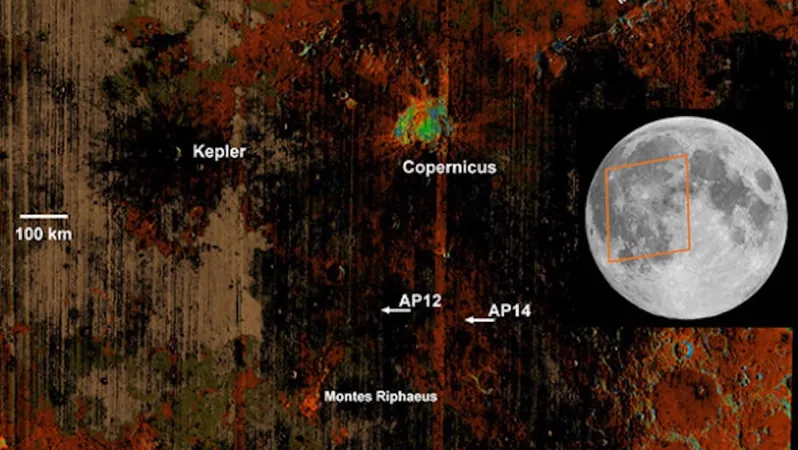
Breakthrough in Planetary Exploration: Meet the Tetracorder, Your New Favorite Space Gadget!
2025-01-07
Author: Jia
Introduction to the Tetracorder
In the world of space exploration, the tech we once only saw in science fiction is inching closer to reality. While the iconic tricorder from Star Trek allowed explorers to gather vital data about their surroundings, scientists have surpassed that ingenious device with an advanced tool called the Tetracorder.
Revolutionary Features
So, what makes the Tetracorder so revolutionary? This high-tech instrument utilizes imaging spectrometer data to swiftly analyze the light patterns emitted or reflected from vast expanses of land, sea, and sky. According to a recent publication in the Planetary Science Journal, researchers have successfully enhanced the Tetracorder's capabilities, enabling it to create detailed mineral maps in record time. The study also highlights promising field tests demonstrating the Tetracorder's suitability for deployment on robotic rovers, thus revolutionizing autonomous exploration.
Leading the Research Team
Leading the charge in this innovative venture is Roger Clark, a Senior Scientist at the Planetary Science Institute (PSI), along with co-authors Eldar Noe Dobrea, Amanda Hendrix, and Neil Pearson. Together, they spearhead a team of researchers who have dedicated decades to refining this transformative technology.
NASA's Involvement with the Tetracorder
Currently, the Tetracorder is at the forefront of NASA's Earth Surface Mineral Dust Source Investigation (EMIT) initiative aboard the International Space Station (ISS). This project has recently received an extension, allowing it to continue mapping essential earthly components like minerals, dust, and even snow and ice. "Back in the 1980s and 90s, analyzing a handful of spectra could take weeks," recalls Clark. "Now, with imaging spectrometers, we’re able to process millions of spectra per minute, reshaping how we conduct analyses."
Latest Findings with the Tetracorder
One striking visualization produced by the Tetracorder is a color map derived from data collected in the Chile-Argentina snow-capped mountains. This map reveals fascinating insights, indicating that snow at higher elevations shows no signs of melting (illustrated in magenta) while lower elevations (in blue) experience melting. Beyond just aesthetics, these maps are treasure troves of information on various compounds, including water, impurities, and organic materials.
Exploration Beyond Earth
Researchers recently turned their sights toward the Moon, successfully using the Tetracorder to locate water and hydroxyl signatures. Furthermore, the device is set to play a crucial role in missions aimed at understanding Europa, one of Jupiter's most intriguing moons. Launched on October 14, 2024, the Europa Clipper mission includes the Mapping Imaging Spectrometer for Europa (MISE), which will gather data to help assess the moon's habitability by examining its surface composition. Clark emphasizes, “Determining Europa's surface composition is key to unveiling its potential for supporting life.”
Future Missions and Funding
The combined data from MISE and Tetracorder will not only inform us about Europa’s icy shell but will also guide future missions, pinpointing optimal locations for landers and potentially rovers to conduct in-depth exploration of the moon's geological wonders. Funding for this groundbreaking work comes through various NASA projects, highlighting the importance and excitement of ongoing advancements in planetary science. As we inch closer to becoming interstellar voyagers, the Tetracorder may just be the gadget that propels us into a new era of exploration. Stay tuned, because the cosmos just got a whole lot more accessible!


 Brasil (PT)
Brasil (PT)
 Canada (EN)
Canada (EN)
 Chile (ES)
Chile (ES)
 Česko (CS)
Česko (CS)
 대한민국 (KO)
대한민국 (KO)
 España (ES)
España (ES)
 France (FR)
France (FR)
 Hong Kong (EN)
Hong Kong (EN)
 Italia (IT)
Italia (IT)
 日本 (JA)
日本 (JA)
 Magyarország (HU)
Magyarország (HU)
 Norge (NO)
Norge (NO)
 Polska (PL)
Polska (PL)
 Schweiz (DE)
Schweiz (DE)
 Singapore (EN)
Singapore (EN)
 Sverige (SV)
Sverige (SV)
 Suomi (FI)
Suomi (FI)
 Türkiye (TR)
Türkiye (TR)
 الإمارات العربية المتحدة (AR)
الإمارات العربية المتحدة (AR)